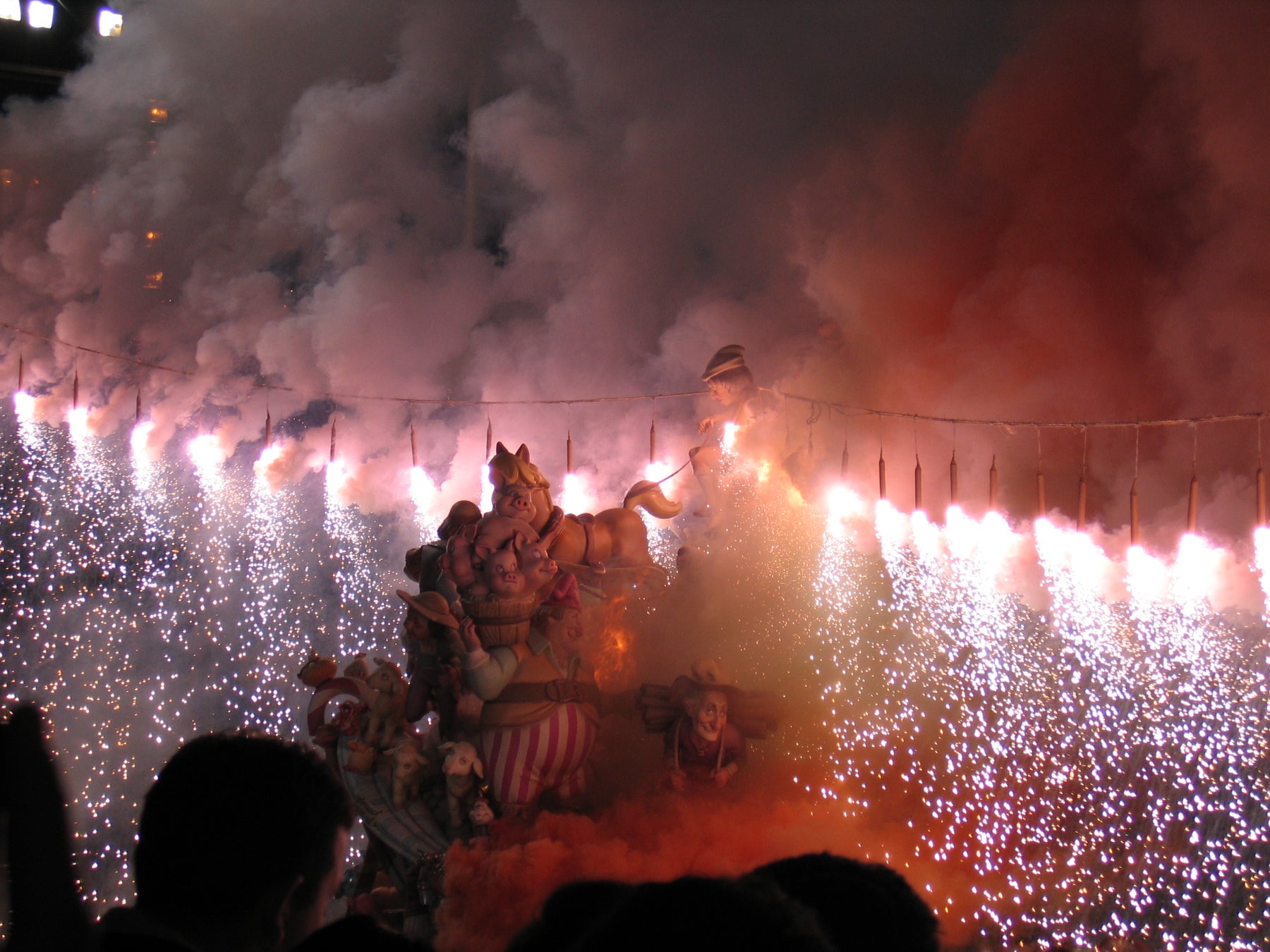
Las Fallas - Biggest Festival in Valencia
LAS FALLAS Each year on 19 March, the province of Valencia on the Spanish east coast erupts into a frenzy of energetic pyromania and destruction.
The conclusion of the four-day festival - Las Fallas - this one night sees the purposeful destruction of over 700 papier-mâché statues, some of which are up to 100 feet tall. Literally thousands of fire-fighting volunteers are on stand by, often in the most miniscule of squares in the heart of the city's residential areas, to supervise the ritual sacrifice of these brightly coloured statues. The mass firestorm’s results are as baffling to an outsider as they are fierce.
The whole city of Valencia has set itself on fire. No one knows exactly how Las Fallas began. Some say that the carpenters, who have St. Joseph as their patron saint, used the feast day as an occasion to clean out their workshops, burning their bits and pieces of scrap wood in the square near their shops. These small annual bonfires then came to be associated with festivals marking the beginning of spring; at some point, dolls were made for the festival, then statues, and eventually the beautiful and intricate, towering fallas we see today. Beginning on the 15th March, every neighborhood in Valencia assembles their giant, elaborate, papier-mâché, wood, and wax effigies, in the city’s squares.
Then on St. Joseph’s day (San José), March 19, La Crema commences — the simultaneous destruction of the fallas in an enormous inferno of some 700 fires set in the city’s many squares, years worth of planning preparation and loving craftsmanship, up in smoke in a matter of minutes. A massive amount of work goes into the creation of every statue. Planning begins for next year’s festival as soon as this year ends. Hundreds of committees discuss ideas and make the extensive preparations. Normally, each statue consists of one very tall beautiful figure surrounded by several smaller, life-size statues; many of the secondary pieces are grotesque and ugly. Each component of the statue is brightly decorated and has exaggerated features. Provocative images like bare-breasted women are very common nowadays.
Sometimes the principal designer will even include a caricature of himself at the base of the central construction, making his mark on the statue, similar to how an artist would sign a painting. These large fallas are almost always accompanied by smaller, separate displays put together by the children from each local area. This way the skills involved in making the fallas are passed down from generation to generation; this may explain the outstanding quality of these works of art. Around these festivities — the music, bullfights, fireworks, and fallas — Valencia offers some of the most beautiful cathedrals and churches in Spain, perhaps Spain’s best covered market, the sensuous Silk Market, the spectacular modern architecture of La Ciudad de las Artes y de las Ciencias, one of the world’s largest aquariums and the wonderful traditional paellas available at most restaurants and cafes.
It really is a feast for all the senses. However, there is one thing that everyone looks forward to experiencing, the fireworks; which the Spanish are particularly good at. Each day there are two separate displays. The first is called la mascleta, takes place every day at 2p.m. and is unmistakable in its ferocity of sound. Mascleta explosions erupt in the city sky for about 5 minutes of non- stop aural bombardment. Imagine hundreds of cannon fired off one after the other, building gradually in intensity to a cacophony of explosions that literally shake the earth beneath the feet and leaves spectators in awe. This is Valencia’s annual gift to its people. The second display, in the evening, is far more traditional – and much more spectacular. This takes place along the dry river bed which snakes through the city centre. It usually starts late at night - at midnight or 1am - and is one of the best pyrotechnic displays anywhere in the world.
The Spanish are renowned experts at this kind of event, though the locals always show a blasé attitude to the display. The fireworks, they will invariably say, are not as good as last years. Each of the large fallas are rigged with explosives and the crowds gather around their favourite one to witness its fiery demise. Elaborate ways of ignition are used, sometimes involving jets of fire and spiraling fuses, which helps to build up the anticipation in the audiences, finally the moment arrives and almost simultaneously all 700 Fallas are set alight across the city, and is met with another mascleta style bombardment of the ears, the shrieking and cheering of the locals as they see the culmination of a years planning turned to smoke and ash. . But the evening is not over yet.
Now the crowds snake their way through the narrow streets towards the city’s centre where one last falla remains to be destroyed. It is the largest and most beautiful of them all, and its burning will indicate the grand finale of the festival. The main square is filled with spectators. Cheering and awaiting the final burning, another huge series of aerial fireworks accompany this last fallas and as it disappears, so does the last remnant of the years celebrations. Tomorrow, planning will begin for next year. Immediately after the burning, the crowds depart quickly to the bars and restaurants and a mass of cleaners set to work. By the time the city awakens in the morning, there is nothing left of the night's celebrations but a lasting memory in the hearts and minds - and possibly the ears - of its citizens.
Las Fallas is best described as well organised chaos. It defies logical analysis. It is an insane frenzy of fire and light, organised with all the precision of a military operation. For this reason, it is perhaps Western Europe's finest festival for pyro lovers everywhere.

Leave a comment